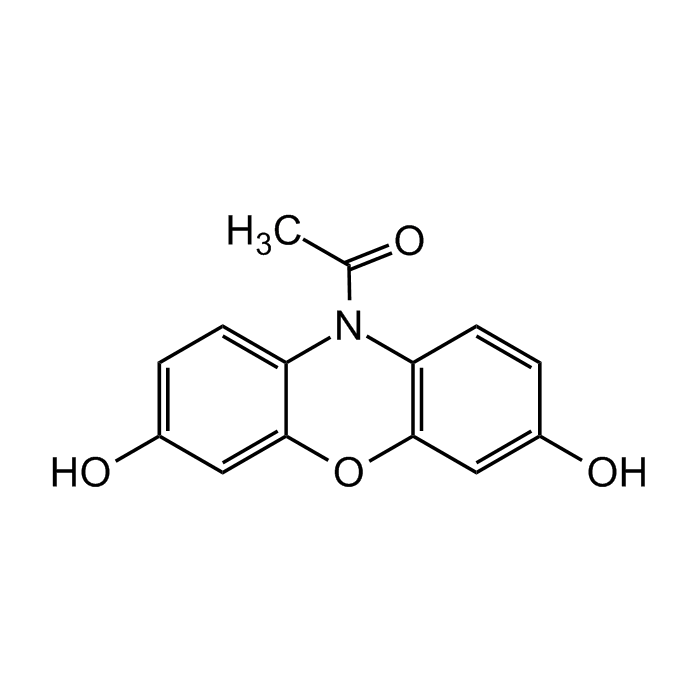Cookie Policy: This site uses cookies to improve your experience. You can find out more about our use of cookies in our Privacy Policy. By continuing to browse this site you agree to our use of cookies.
Chemodex
10-Acetyl-3,7-dihydroxyphenoxazine

| Product Details | |
|---|---|
| Synonyms | Amplex® Red (Registered trademark of LifeTechnologies) |
| Product Type | Chemical |
| Properties | |
| Formula |
C14H11NO4 |
| MW | 257.24 |
| CAS | 119171-73-2 |
| Source/Host Chemicals | Synthetic. |
| Purity Chemicals | ≥98% (HPLC) |
| Appearance | Solid. |
| Solubility | Soluble in DMSO or DMF. |
| Identity | Determined by 1H-NMR. |
| Declaration | Manufactured by Chemodex. |
| Other Product Data |
Click here for Original Manufacturer Product Datasheet |
| InChi Key | PKYCWFICOKSIHZ-UHFFFAOYSA-N |
| Smiles | CC(=O)N1C2=CC=C(O)C=C2OC2=C1C=CC(O)=C2 |
| Shipping and Handling | |
| Shipping | AMBIENT |
| Short Term Storage | +4°C |
| Long Term Storage | -20°C |
| Handling Advice | Protect from light and moisture. |
| Use/Stability | Stable for at least 2 years after receipt when stored at -20°C. |
| Documents | |
| MSDS |
 Download PDF Download PDF |
| Product Specification Sheet | |
| Datasheet |
 Download PDF Download PDF |
10-acetyl-3,7-dihydroxyphenoxazin (Amplex Red) is a non-fluorescent, highly sensitive and stable probe for H2O2. Amplex Red is an applicable as a fluorogenic substrate for peroxidase. In the presence of horseradish peroxidase (HRP), the Amplex Red reagent reacts in a 1:1 stechiometry with H2O2 to produce highly fluorescent resorufin. Because H2O2 is produced in many different enzymatic reactions, the Amplex Red reagent allows researchers to detect the activity of many different enzymes. 10-acetyl-3,7-dihydroxyphenoxazin has absorption and fluorescence emission maxima of approximately 563 nm and 587 nm, respectively, and because its extinction coefficient is high (54,000 cm-1M-1), the assay can be performed either fluorometrically or spectrophotometrically.
(1) I. Snyrychova et al.; Phys. Plantarum, 135(1), 1-18 (2009) | (2) J.G. Montay et al.; J. Immunol. Meth. 202, 133 (1997) | (3) M. Zhou et al.; Anal. Biochem. 253, 162 (1997) | X. Cao, et al.; Lab Chip ahead of print (2023) | N. Cvjetan, et al.; ACS Omega (2023)








